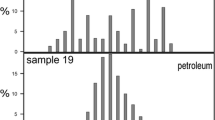Abstract
State and federal agencies are beginning to monitor ambient air for compounds related to diesel exhaust. The National Institute of Standards and Technology (NIST) was asked to develop standards containing heavy (C10–C16) alkanes which could then be used in air monitoring and exhaust studies. Several primary gravimetric standards, containing heavy (C10–C16) alkanes in nitrogen, were developed and analyzed by gas chromatography (GC) with flame-ionization detection (FID). The results of this research indicate that accurate gas standards containing these hydrocarbons can be prepared. However, the analytical results show that the temperature of the transfer system from the gas cylinder to the GC column (including the gas-sample valve) must be heated in order to prevent adsorption of these compounds within the analytical system. The results indicate that even at elevated temperatures these compounds are being absorbed within the system. The results show that quantitative results cannot be obtained by using one compound such as hexane, as an internal standard to determine the concentration of other hydrocarbons. Quantitative and accurate results are best obtained if standards for each hydrocarbon of interest are used to determine concentrations of unknowns for the respective hydrocarbon.



Similar content being viewed by others
Notes
Certain commercial equipment, instruments, or materials are identified in this paper to adequately specify the experimental procedure. Such identification does not imply recommendation or endorsement by the National Institute of Standards and Technology, nor does it imply that the materials or equipment identified are necessarily the best available for the purpose.
References
Nauss K (1997) Diesel exhaust: a critical analysis of emissions, exposure, and health effects, Health Effects Institute (HEI), Diesel Net Technical Report, http://www.DieselNet.com, October
CARB (1998) Findings of scientific review panel on: the report on diesel exhaust, CARB, Rockville, MD
NIOSH (1998) NIOSH current intelligence bulletin No. 50, NIOSH, Atlanta, GA
California Environmental Protection Agency (1994) Office of environmental health assessment, June, Cal. EPA, Sacramento, CA
US EPA. Health assessment document for diesel emission (external review draft), Vols. I–III, EPA/600/8-90/057, US EPA, Washington, DC
Mauderly JL (1992) Diesel exhaust, chapter 5. In: Lippman M (ed) Van Nostrand Reinhold, New York, pp 119–162
IARC (1989) International Agency for Research on Cancer, Vol. 46, IARC, Lyon, France
VPIRG, Environmental Health Effects of Diesel Engines, http://www.vprig.org/pubs/fs_diesel.html, Montpelier, Vermont
US EPA (2002) FACT SHEET: release of the health assessment document for diesel engine exhaust, September, US EPA, Washington, DC
Environment and Human Health, Inc. (2002) EHHI releases original research report, children’s exposure to diesel exhaust on school buses, http://www.ehhi.org, Hartford, CT, February
Backer R, Denton D, Woodward C, Miller R, Reducing diesel particulate exposure in Western Mines, NIOSH, Spokane Research Laboratory, http://www.cdc.gov/niosh/mining/projects/rdpei.html
The Swedish Fire Department, Stockholm, Sweden, http://www.plymovent.se/engelsk/fire.asf.htm
Lavoie J (1988) IRSST, 087-035, IRSST, Montreal
Rhoderick GC, Miller WR (1993) J Chromatogr A 653:71–81
Rhoderick GC, Fresenius (1997) J Anal Chem 359:477–483
Helmig D, Revermann T, Hall B (2004) Anal Chem 76:6528–6534
Reid RC, Prausnitz JM, Poling BE (1987) The properties of gases and liquids, 4th edn.
Katritzky AR et al (1994) Anal Chem 66:1799–1807
Dietz WA (1967) J Chromatogr 5:68–71
NIST ROA (1994) 835-94-083, NIST, Gaithersburg, MD
Acknowledgements
The author wishes to acknowledge the California Air Resources Board (CARB) and the National Center for Atmospheric Research (NCAR) for the partial support provided for this research and development.
Author information
Authors and Affiliations
Corresponding author
Rights and permissions
About this article
Cite this article
Rhoderick, G.C. Feasibility of preparing and analyzing gas standards containing heavy hydrocarbons (C10–C16). Anal Bioanal Chem 385, 866–874 (2006). https://doi.org/10.1007/s00216-006-0494-2
Received:
Revised:
Accepted:
Published:
Issue Date:
DOI: https://doi.org/10.1007/s00216-006-0494-2




